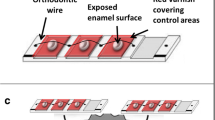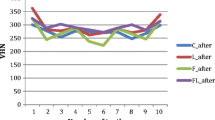Abstract
This study evaluated in vitro the effect of input power of CO2 laser, either associated or not to stannous fluoride (SnF2) gel, for the control of intrinsic erosion in primary teeth. One hundred four enamel slabs (3 × 3 × 2 mm) from human primary molars were flattened and polished. Adhesive tapes were placed on their surface leaving a window of 3 × 1 mm. Slabs were then cycled four times in 0.01 M hydrochloric acid (pH 2, 2 min) and in artificial saliva (2 h) for creation of erosive lesions. Specimens were randomly assigned into eight groups (n = 13) according to fluoride application [absent (control) or 0.4 % stannous fluoride gel (SnF2)] and input power of CO2 laser [unlased (control), 0.5, 1.0 or 1.5 W]. The CO2 laser irradiation was performed in an ultra-pulse mode (100 μs of pulse duration), 4-mm working distance, for 10 s. Specimens were then submitted to further erosive episodes for 5 days and evaluated for enamel relative permeability. Fluoride did not show any protective effect for any of the laser-treated groups or control (p = 0.185). However, a significant effect was detected for input power of CO2 laser (p = 0.037). Tukey’s test showed that there was a significant statistically difference between specimens irradiated with 0.5 and 1.5 W (p = 0.028). The input power of 0.5 W showed lower permeability. Variation of input power CO2 laser can influence enamel permeability, at the power of 1.5 W which promoted greater permeability.
Similar content being viewed by others
References
Tao DY, Hao G, Lu HX, Tian Y, Feng XP (2015) Dental erosion among children aged 3–6 years and its associated indicators. J Public Health Dent. doi:10.1111/jphd.12098
Ten Cate JM, Imfeld T (1996) Dental erosion, summary. Eur J Oral Sci 104(2):241–4
Linnett V, Seow WK (2001) Dental erosion in children: a literature review. Pediatr Dent 23(1):37–43
Dahshan A, Patel H, Delaney J, Wuerth A, Thomas R, Tolia V (2002) Gastroesophageal reflux disease and dental erosion in children. J Pediatr 140(4):474–8
Corica A, Caprioglio A (2014) Meta-analysis of the prevalence of tooth wear in primary dentition. Eur J Paediatr Dent 15(4):385–8
Ten Cate JM, Larsen MJ, Pearce EIF, Fejerskov O (2008) Chemical interaction between the tooth and the oral fluids. In: Fejerskov O, Kidd EAM (eds) Dental caries: the disease and its clinical management, 2nd edn. Blackwell Publishing Ltd, Oxford, pp 209–31
Bartlett DW, Coward PY (2001) Comparison of erosive potential of gastric juice and a carbonated drink in vitro. J Oral Rehabil 28:1045–1047
Amaechi BT, Higham SM, Edgar WM (1999) Factors influencing the development of dental erosion in vitro: enamel type, temperature and exposure time. J Oral Rehabil 26(8):624–30
van Rijkom H, Ruben AJV, Huysmans MC, Truin GJ, Mulder J (2003) Erosion inhibiting effect of sodium fluoride and titanium tetrafluoride treatment in vitro. Eur J Oral Sci 111:253–257
Larsen MJ (2001) Prevention by means of fluoride of enamel erosion as caused by soft drinks and orange juice. Caries Res 35(3):229–34
Larsen MJ, Richards A (2002) Fluoride is unable to reduce dental erosion from soft drinks. Caries Res 36(1):75–80
Ganss C, Schlueter N, Hardt M, Schattenberg P, Klimek J (2008) Effect of fluoride compounds on enamel erosion in vitro—a comparison of amine, sodium and stannous fluoride. Caries Res 42:2–7
Schlueter N, Duran A, Klimek J, Ganss C (2009) Investigation of the effect of various fluoride compounds and preparations thereof on erosive tissue loss in enamel in vitro. Caries Res 43:10–16. doi:10.1159/000189702
Comar LP, Gomes MF, Ito N, Salomão PA, Grizzo LT, Magalhães AC (2012) Effect of NaF, SnF2, and TiF4 toothpastes on bovine enamel and dentin erosion-abrasion in vitro. Int J Dent 2012:134350. doi:10.1155/2012/134350
Ganss C, Klimek J, Schäffer U, Spall T (2001) Effectiveness of two fluoridation measures on erosion progression in human enamel and dentine in vitro. Caries Res 35(5):325–30
Schlueter N, Hardt M, Lussi A, Engelmann F, Klimek J, Ganss C (2009) Tin-containing fluoride solutions as anti-erosive agents in enamel: an in vitro tin-uptake, tissue-loss, and scanning electron micrograph study. Eur J Oral Sci 117(4):427–34. doi:10.1111/j.1600-0722.2009.00647.x
Wiegand A, Magalhães AC, Navarro RS, Schmidlin PR, Rios D, Buzalaf MA et al (2010) Effect of titanium tetrafluoride and amine fluoride treatment combined with carbon dioxide laser irradiation on enamel and dentin erosion. Photomed Laser Surg 28(2):219–26. doi:10.1089/pho.2009.2551
Steiner-Oliveira C, Nobre-dos-Santos M, Zero DT, Eckert G, Hara AT (2010) Effect of a pulsed CO2 laser and fluoride on the prevention of enamel and dentine erosion. Arch Oral Biol 55(2):127–33. doi:10.1016/j.archoralbio.2009.11.010
Esteves-Oliveira M, Pasaporti C, Heussen N, Eduardo CP, Lampert F, Apel C (2011) Rehardening of acid-softened enamel and prevention of enamel softening through CO2 laser irradiation. J Dent 39(6):414–21
Siqueira Scatolin R, Luiz Alonso-Filho F, Galo R, Rios D, Cristina Borsatto M, Aparecida Milori Corona S (2015) CO2 laser emission modes to control enamel erosion. Microsc Res Tech 78(8):654–9. doi:10.1002/jemt.22518
Steiner-Oliveira C, Rodrigues LK, Soares LE, Martin AA, Zezell DM, Nobre-dos-Santos M (2006) Chemical, morphological and thermal effects of 10.6-microm CO2 laser on the inhibition of enamel demineralization. Dent Mater J 25(3):455–62
Nelson DGA, Featherstone JDB (1982) Preparation, analysis, and characterization of carbonated apatites. Calcif Tissue Int 34:S69–S81
Nelson DGA, Williamson BE (1982) Low-temperature laser Raman spectroscopy of synthetic carbonated apatites and dental enamel. Aust J Chem 35:715–727
Nelson DG, Wefel JS, Jongebloed WL, Featherstone JD (1987) Morphology, histology and crystallography of human dental enamel treated with pulsed low energy infrared laser radiation. Caries Res 21:411–426
Lepri TP, Colucci V, Turssi CP, Corona AS (2013) Permeability of eroded enamel following application of different fluoride gels and CO2 laser. Lasers Med Sci 28(1):235–40. doi:10.1007/s10103-012-1123-2
Ramalho KM, Eduardo C de P, Heussen N, Rocha RG, Lampert F, Apel C et al. Protective effect of CO2 laser (10.6 μm) and fluoride on enamel erosion in vitro. Lasers Med Sci 28(1):71–8 doi: 10.1007/s10103-012-1071-x
Nakagaki S, Iijima M, Endo K, Saito T, Mizoguchi I (2015) Effects of CO2 laser irradiation combined with fluoride application on the demineralization, mechanical properties, structure, and composition of enamel. Dent Mater J 34(3):287–93. doi:10.4012/dmj.2014-225
Souza MR, Watanabe I, Azevedo LH, Tanji EY (2009) Morphological alterations of the surfaces of enamel and dentin of deciduous teeth irradiated with Nd:YAG, CO2 and diode lasers. Int J Morphol 27(2):441–446
Johansson AK, Sorvari R, Birkhed D, Meurman JH (2001) Dental erosion in deciduous teeth—an in vivo and in vitro study. J Dent 29(5):333–40
Carrasco LD, Froner IC, Corona SA, Pécora JD (2003) Effect of internal bleaching agents on dentinal permeability of non-vital teeth: quantitative assessment. Dent Traumatol 19:85–89
Turssi CP, Alves VD, Serra MC (2005) Suitability of bovine root dentin for studies on permeability of erosion lesions. Caries Res 39(132):287–340
Ersin NK, Onçağ O, Tümgör G, Aydoğdu S, Hilmioğlu S (2006) Oral and dental manifestations of gastroesophageal reflux disease in children: a preliminary study. Pediatr Dent 28(3):279–84
Jaeggi T, Lussi A (2014) Prevalence, incidence and distribution of erosion. Monogr Oral Sci 25:55–73. doi:10.1159/000360973
Tolia V, Vandenplas Y (2009) Systematic review: the extra-oesophageal symptoms of gastro-oesophageal reflux disease in children. Aliment Pharmacol Ther 29(3):258–72
Wilder-Smith CH, Materna A, Martig L, Lussi A (2015) Gastro-oesophageal reflux is common in oligosymptomatic patients with dental erosion: a pH-impedance and endoscopic study. United Eur Gastroenterol J 3(2):174–81. doi:10.1177/2050640614550852
Willumsen T, Ogaard B, Hansen BF, Rølla G (2004) Effects from pretreatment of stannous fluoride versus sodium fluoride on enamel exposed to 0.1 M or 0.01 M hydrochloric acid. Acta Odontol Scand 62(5):278–81
Hove L, Holme B, Øgaard B, Willumsen T, Tveit AB (2006) The protective effect of TiF4, SnF2 and NaF on erosion of enamel by hydrochloric acid in vitro measured by white light interferometry. Caries Res 40(5):440–3
Hove LH, Young A, Tveit AB (2007) An in vitro study on the effect of TiF(4) treatment against erosion by hydrochloric acid on pellicle-covered enamel. Caries Res 41(1):80–4
Ramos-Oliveira TM, Ramos TM, Esteves-Oliveira M, Apel C, Fischer H, de Eduardo CP et al (2014) Potential of CO2 lasers (10.6 μm) associated with fluorides in inhibiting human enamel erosion. Braz Oral Res 28:1–6
Fowler BO, Kuroda S (1986) Changes in heated and in laser-irradiated human tooth enamel and their probable effects on solubility. Calcif Tissue Int 38(4):197–208
Tsai CL, Lin YT, Huang ST, Chang HW (2002) In vitro acid resistance of CO2 and Nd-YAG laser-treated human tooth enamel. Caries Res 36(6):423–9
Schlueter N, Klimek J, Ganss C (2011) Efficacy of tin-containing solutions on erosive mineral loss in enamel and dentine in situ. Clin Oral Investig 15(3):361–7. doi:10.1007/s00784-010-0386-x
Lippert F, Parker D, Jandt K (2004) Susceptibility of deciduous and permanent enamel to dietary acid-induced erosion studied with atomic force microscopy nanoindentation. Eur J Oral Sci 112:61–6
Wilson PR, Beynon AD (1989) Mineralization differences between human deciduous and permanent enamel measured by quantitative microradiography. Arch Oral Biol 34(2):85–8
de Menezes Oliveira MA, Torres CP, Gomes-Silva JM, Chinelatti MA, de Menezes FC, Palma-Dibb RG et al (2010) Microstructure and mineral composition of dental enamel of permanent and deciduous teeth. Microsc Res Tech 73(5):572–7. doi:10.1002/jemt.20796
Acknowledgments
The authors would like to gratefully acknowledge Fundação de Amparo à Pesquisa do Estado de São Paulo (FAPESP) for the scholarship of the first author during her PhD program with grant 2008/01256-0.
Author information
Authors and Affiliations
Corresponding author
Rights and permissions
About this article
Cite this article
Rocha, C.T., Turssi, C.P., Rodrigues-Júnior, A.L. et al. Impact of CO2 laser and stannous fluoride on primary tooth erosion. Lasers Med Sci 31, 567–571 (2016). https://doi.org/10.1007/s10103-016-1903-1
Received:
Accepted:
Published:
Issue Date:
DOI: https://doi.org/10.1007/s10103-016-1903-1




